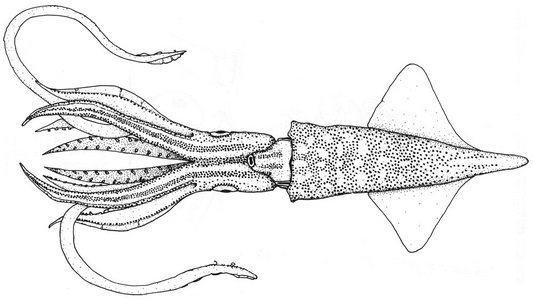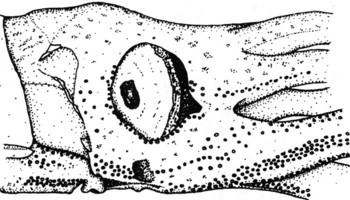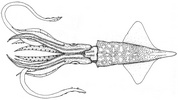Enoploteuthis galaxias
Kotaro TsuchiyaIntroduction
Enoploteuthis galaxias is associated with the temperate shelf waters of northern New Zealand and South Australia. This species resembles to North Pacific species E. chuni both in morphology and ecology.
Characteristics
- Tentacle
- Tentacle long, with distinct club.
- Carpal cluster oval.
- Two rows of different-sized hooks on manus.
- Four rows of suckers on dactylus.
- Hectocotylus
- Hectocotylus with two different-sized offset flaps.
- Modified portion with armature.
- Integumental Photophores
- Ventral mantle anteriorly with six longitudinal stripes of integumental organs, which are interconnected with addiotional organs to form fenestrae; stripes become diffused posteriorly; fenestrate arrangement obscured with growth due to increasing numbers of organs.
- Ventral head with three wide longitudinal stripes of integumental organs.
- Ventral side of arm III with a series of organs along almost entire length.
Comment
Taxonomic status with the south temperate Pacific species, E. semilineata Alexeyev, 1994 is uncertain. It is known from E. chuni that the photophore arrangement changes with growth due increasing of numbers of organs causing stripes to diffuse posteriorly.
Distribution
Vertical distribution
This species seems to be a mesopelagic boundary species (Young, 1995).
Geographical distribution
This species was known only from the shelf waters of South Australia and northern coast of New Zealand (Riddell, 1985).References
Riddell, D.J. 1985. The Enoploteuthidae (Cephalopoda: Oegopsida) of the New Zealand region. Fisheries Reserch Bulletin (NZ), 27:1-52.
Young, R.E. 1995. Aspects of the natural history of pelagic cephalopods of the Hawaiian mesopelagic-boundary region. Pacific Science, 49:143-155.
About This Page

Tokyo University of Fisheries, Tokyo, Japan
Page copyright © 2015
All Rights Reserved.
- Content changed 23 July 2009
Citing this page:
Tsuchiya, Kotaro. 2009. Enoploteuthis galaxias . Version 23 July 2009 (under construction). http://tolweb.org/Enoploteuthis_galaxias/19707/2009.07.23 in The Tree of Life Web Project, http://tolweb.org/












 Go to quick links
Go to quick search
Go to navigation for this section of the ToL site
Go to detailed links for the ToL site
Go to quick links
Go to quick search
Go to navigation for this section of the ToL site
Go to detailed links for the ToL site